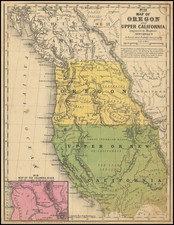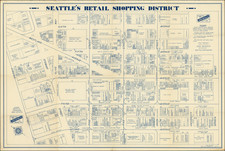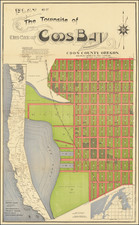Fascinating transitional map of Washington, Oregon and Idaho Territory, showing a massive Idaho Territory, pre-dating the creation of Wyoming Territory (1868) and Montana Territory (1864).
Shows the early evolution of Western Territorial Borders. Shows early counties, roads, Indian tribes, forts, etc. Immediately prior to exploration of Yellowstone Park.
An unusual map with early counties in Northwestern Idaho. One of the best transitional maps of the Northwest.
Idaho Territory was officially established on March 3, 1863, by an Act of Congress and signed into law by President Abraham Lincoln. It initially included all of the present-day states of Idaho and Montana, as well as almost all of the present-day state of Wyoming, except for a small southwestern portion. Lewiston was the first territorial capital from 1863 to 1866, after which Boise was designated as the capital.
The territory's borders shifted several times in the following years. In 1864, the Montana Territory was formed from the northeastern section of Idaho Territory, east of the Bitterroot Range, and most of the southeastern area became part of Dakota Territory. Then in 1868, areas east of the 111th meridian west were designated as part of the newly created Wyoming Territory.
States of the Map (based upon the title):
- 1864 Johnson's Washington, Oregon and Idaho (British Columbia named above Washington)
- 1864 Johnson's Washington, Oregon and Idaho (British Columbia” in western Canada has been changed to “British Columbia Possessions”; In title “Idaho” is in dark black, non-italic outlined letters.
- 1864-65 Johnson's Washington, Oregon and Idaho (“IDAHO” is shown in outline and Montana is now named).
Benjamin P. Ward was an American publisher. He was best known for his partnership with A. J. Johnson. In 1860, the Johnson firm published its first significant work, the Johnson’s New Illustrated (Steel Plate) Family Atlas. The first edition of the Atlas bears imprints in both New York and Richmond, VA. In 1861, however, following the outbreak of the American Civil War, the Johnson & Browning firm abandoned their Richmond location. Browning seems to have remained in Virginia to pursue other ventures and, in 1861, Browning’s portion of the firm was purchased by Ward. The 1863 issue of the Atlas was one of the most unusual, it being a compilation of older Johnson and Browning maps, updated 1862 Johnson and Ward maps, and newer 1863 maps with a revised border design. The 1864 issue of the Atlas is the first true Johnson and Ward atlas. Johnson published one more edition in partnership with Ward in 1865, after which Johnson becomes the sole publisher.
Alvin Jewett Johnson (1827 - 1884) was an American map publisher. Born in Wallingford, Vermont, he received only a basic public education, but he still served as a school teacher for several years before moving to Richmond, Virginia and, in 1857, New York City. Johnson also worked as a book canvasser for the map publisher J.H. Colton.
Johnson's name first appears on maps published with Samuel N. Gaston and D. Griffing Johnson (no clear relation) in the mid-1850s, and his name (along with Ross Browning) appeared on Colton's atlas maps of 1859 and 1860. Although map historian Water Ristow speculates that Colton sold his copyrights to Johnson and his business partner, fellow Vermonter Browning, a more likely theory is that Johnson and Browning financially bailed out the Colton firm in exchange for the right to use Colton’s existing copyrighted map plates. The first Johnson maps were mostly reissues of earlier Colton maps. Indeed, Johnson's earliest works described his firm as the “Successors to J. H. Colton and Company”. Johnson converted the original Colton steel plate engravings to lithographic stones, allowing his firm to produce more maps at a lower price point.
In 1860, the Johnson firm published its first significant work, the Johnson’s New Illustrated (Steel Plate) Family Atlas. The first edition of the Atlas bears imprints in both New York and Richmond, VA. In 1861, however, following the outbreak of the American Civil War, the Johnson & Browning firm abandoned their Richmond location. Browning seems to have remained in Virginia to pursue other ventures and, in 1861, Browning’s portion of the firm was purchased by Benjamin P. Ward. The 1863 issue of the Atlas was one of the most unusual, it being a compilation of older Johnson and Browning maps, updated 1862 Johnson and Ward maps, and newer 1863 maps with a revised border design.
The 1864 issue of the Atlas is the first true Johnson and Ward atlas. Johnson published one more edition in partnership with Ward in 1865, after which Johnson becomes the sole publisher. The next issue of the Atlas, 1866, is the first purely Johnson atlas with all new map plates, updated imprints, and copyrights. Johnson maps include a unique border style, which changed over the years, but was not copied by other makers. These include a “strapwork border” from 1860 to 1863, a “fretwork border” from 1863 to 1869 and a “spirograph border” in 1870.
In addition to the Family Atlas, Johnson issued numerous wall maps, pocket maps, and, in the 1880s, the Cyclopedia. Johnson frequently updated his western atlas maps and on occasion, more than one update appeared in a single year. Johnson continued to publish the Family Atlas until 1887. In 1879, Johnson brought his son into the business, and their publications have the imprint “A.J. Johnson and Son” and, later, “A.J. Johnson and Co.” Johnson’s son continued the business until it shuttered in 1887.










![[ Early Automobile Tourism -- Pacific Coast Highways ] (Strip Maps, etc.)](https://storage.googleapis.com/raremaps/img/small/81461.jpg)
![[ Lake Cavenaugh - Lake Creek - Skagit County ] Township No. 33 North, Range No. 6 East, W.M. Wash.](https://storage.googleapis.com/raremaps/img/small/101848.jpg)


![[ Pacific Coast Pictorial Road Maps ] Scenic Touring Scout](https://storage.googleapis.com/raremaps/img/small/101745.jpg)